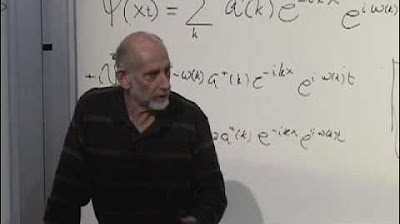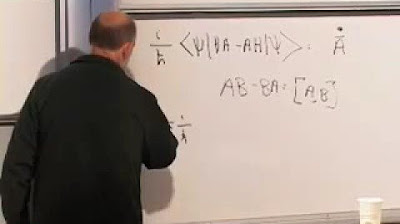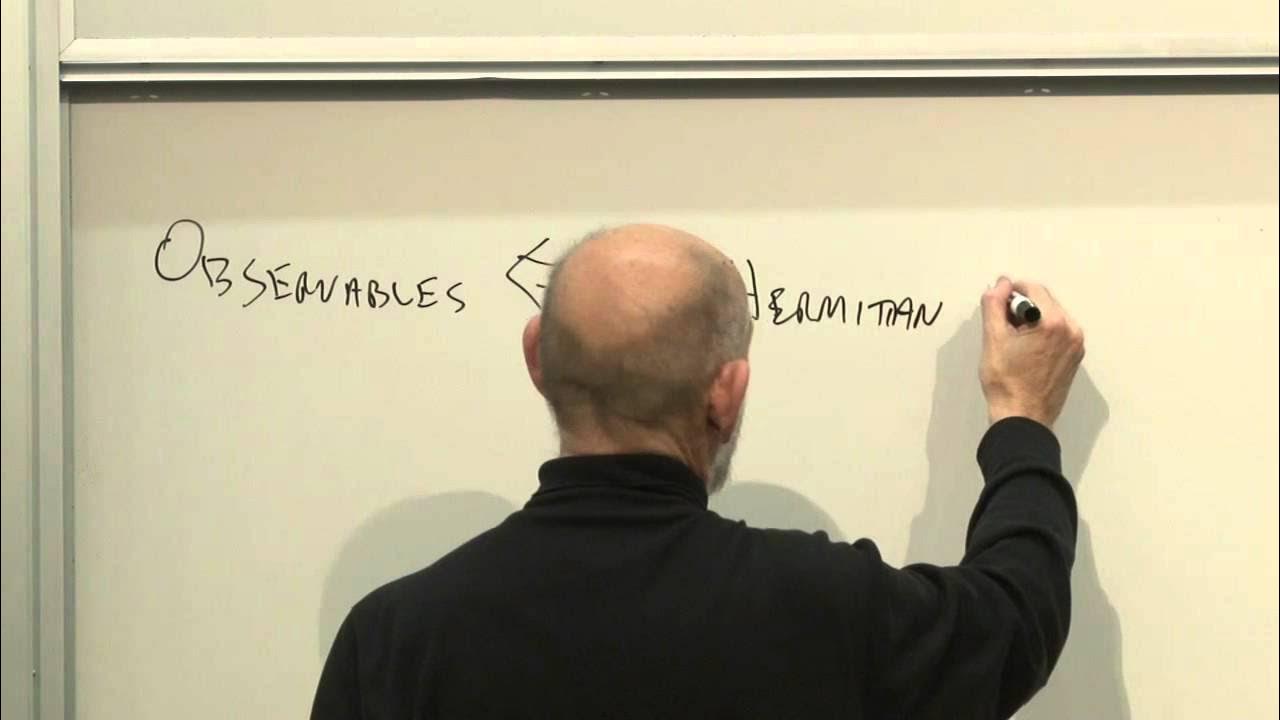Ch 6: What are bras and bra-ket notation? | Maths of Quantum Mechanics
TLDRThis episode delves into the concept of 'bras' in quantum mechanics, emphasizing their role as linear functionals within the Hilbert dual space. It explains how bras, represented by bra-ket notation, are integral to extracting numerical values from quantum states. The video also highlights the power of bra-ket notation by demonstrating its intuitive application in deriving the resolution of the identity, a fundamental concept in quantum physics.
Takeaways
- 🌟 The concept of the 'bra' in quantum mechanics is introduced as a fundamental object, which is a linear functional representing a map from the vector space to a scalar.
- 📐 The example of L_x, a simple linear map in R2, demonstrates how a vector's x-component is returned by this map, showcasing the properties of linear maps.
- 🔍 Linear functionals are defined as linear maps that take a vector as input and return a scalar number, which can be real or complex.
- 📈 The matrix representation of L_x is explored, revealing that it is a 1 by 2 row matrix, which is essentially a column vector on its side.
- 🌐 The dual space, or the space of all linear functionals in R2, is introduced as the vector space formed by all row matrices, which is analogous to the space of column vectors when turned on their side.
- 🤔 The importance of linear functionals in quantum theory is emphasized, as they are essential for extracting values and predictions from quantum states.
- 🎯 The bra symbol in quantum mechanics is ascribed to linear functionals, representing an operator that acts on a ket and returns a number, possibly complex.
- 🔗 The connection between bras and inner products is highlighted by the Riesz Representation Theorem, which states that the action of a linear functional is equivalent to taking the inner product with a unique vector.
- 📊 Bra-ket notation, or Dirac notation, is praised for its power and ease of use, as it allows for the flexible manipulation of inner products and the seamless representation of mathematical relationships.
- 🧠 A resolution of the identity is derived using bra-ket notation, demonstrating the sum of an orthonormal basis expansion must equal the identity operator.
- 🚀 The episode concludes with a teaser for the next topic: how observables are operators in quantum physics, and the implications of this in the broader context of the field.
Q & A
What is the main topic of this episode?
-The main topic of this episode is the introduction of the 'bra' in quantum mechanics and an in-depth exploration of bra-ket notation, emphasizing its power and utility.
What is a linear map in the context of this script?
-A linear map, as discussed in the script, is a function that takes a vector as input and returns a scalar number. It is a fundamental concept in linear algebra and is used to describe operations that preserve the operations of vector addition and scalar multiplication.
What is a linear functional?
-A linear functional is a linear map from a vector space to a scalar field (which can be real or complex numbers). It takes a vector as input and outputs a single number. In the context of the script, linear functionals are represented by 1 by 2 row matrices in R2.
What is the dual space in vector spaces?
-The dual space, formally defined as V*, is the vector space consisting of all linear functionals in V. It is essentially the set of all linear maps from the original vector space V to its scalar field. The dual space is useful in abstract vector spaces and is analogous to the space of row matrices in R2.
How does the concept of a dual space relate to the vector space of column vectors?
-The dual space is related to the vector space of column vectors by being its counterpart where elements (linear functionals) act on vectors to produce scalars. It can be visualized as taking the vector space of column vectors and 'turning them on their side' to form the dual space of linear functionals.
Why are linear functionals important in quantum mechanics?
-Linear functionals are crucial in quantum mechanics because they allow for the extraction of values and predictions from quantum states. They are used to calculate probabilities and expected values of physical quantities, such as energy levels or positions, from quantum states.
What is a bra in quantum mechanics?
-A bra in quantum mechanics is a symbol used to represent a linear functional. It is denoted by a backwards ket and is an operator that acts on a ket (a quantum state) to return a scalar number, which may be real or complex.
How is the action of a bra linear functional mathematically equivalent to an inner product?
-The action of a bra linear functional is mathematically equivalent to taking the inner product with a unique vector, as stated by the Riesz Representation Theorem. This theorem establishes a deep connection between linear functionals and inner products, allowing bras and kets to be manipulated in bra-ket notation seamlessly.
What is the significance of bra-ket notation in quantum mechanics?
-Bra-ket notation, or Dirac notation, is significant in quantum mechanics because it simplifies the mathematical representation of quantum states and operations. It embeds the Riesz Representation Theorem, allowing for the easy manipulation of inner products and linear functionals, and making the mathematical framework of quantum mechanics more intuitive and efficient.
What is a resolution of the identity in the context of this script?
-In the context of this script, a resolution of the identity refers to the expression that shows the sum of bras and kets over an orthonormal basis, when acted upon by the identity operator, results in the identity operator itself. This is a powerful mathematical insight that is easily derived using bra-ket notation.
How does bra-ket notation facilitate the manipulation of quantum states and operators?
-Bra-ket notation facilitates the manipulation of quantum states and operators by allowing for the easy rearrangement of terms and the clear representation of actions between bras, kets, and inner products. This notation streamlines the mathematical process and makes derivations more intuitive, as opposed to traditional vector notation which can be cumbersome.
Outlines
📚 Introduction to Bras and Linear Functionals
This paragraph introduces the concept of bras in quantum mechanics, which are linear functionals represented in bra-ket notation. It begins with an example in R2, defining a simple linear map, L_x, which takes a vector and returns its x-component. The map is shown to be a linear functional, a linear map from the vector space to a scalar number. The concept of linear functionals is then related to the dual space, where the set of all linear functionals in R2 is shown to form a vector space of row matrices. The dual space is a fundamental concept in abstract vector spaces and is related to the idea of extracting values and predictions from quantum states. The paragraph concludes by emphasizing the importance of linear functionals in quantum theory and their representation by bras.
🌟 Bra-Ket Notation and Its Mathematical Power
This paragraph delves into the significance of bra-ket notation in quantum mechanics, explaining how bras, as linear functionals, act on kets to return a number. It highlights the connection between bras and the inner product through the Riesz Representation Theorem, which states that the action of a linear functional is equivalent to taking the inner product with a unique vector. The paragraph demonstrates the power of bra-ket notation through an example involving an orthonormal basis and the expansion of a quantum state. It shows how this notation simplifies the mathematical manipulation of inner products and linear functionals, leading to insights such as the resolution of the identity. The summary emphasizes the intuitive and efficient nature of bra-ket notation compared to traditional vector notation.
Mindmap
Keywords
💡Inner Product
💡Bra
💡Braket Notation
💡Linear Functional
💡Dual Space
💡Riesz Representation Theorem
💡Hilbert Space
💡Observables
💡Resolution of the Identity
💡Quantum State
💡Orthonormal Basis
Highlights
Introduction to the concept of 'bra' in quantum mechanics as a fundamental object.
Explanation of bra-ket notation and its power and usefulness in quantum mechanics.
Example of a simple linear map, L_x, in the vector space of R2.
Verification that L_x is indeed a linear map, satisfying specific properties.
Definition of a linear functional and its role in mapping vectors to scalar numbers.
Determination of the matrix for the linear functional Lx in R2.
Introduction to the concept of the dual space, which is a vector space of all row matrices.
Explanation of how the dual space is analogous to the space of row matrices.
Formal definition of the dual space V* as the vector space of all linear functionals in V.
Discussion on the necessity of linear functionals in quantum physics for making predictions.
Assignment of the special symbol 'bra' to represent linear functionals in quantum mechanics.
Revelation that the action of a bra is mathematically equivalent to taking the inner product with a unique vector.
Introduction to the Riesz Representation Theorem and its significance in the context of linear functionals.
Explanation of how bra-ket notation encapsulates the Riesz Representation Theorem, allowing for flexible manipulation of inner products.
Demonstration of the power of bra-ket notation through an example involving an orthonormal basis and the expansion of a quantum state.
Proof that for any orthonormal basis, a sum of bras and kets equals the identity operator, known as a resolution of the identity.
Comparison of the ease and intuitiveness of bra-ket notation versus traditional vector notation in quantum mechanics.
Conclusion of the discussion on kets and bras in Hilbert space and a preview of the next topic on observables as operators.
Transcripts
Browse More Related Video

Ch 3: Why do we need a Hilbert Space? | Maths of Quantum Mechanics

Lecture 4 | New Revolutions in Particle Physics: Basic Concepts

Lecture 10: Clicker Bonanza and Dirac Notation

Lecture 9 | Quantum Entanglements, Part 1 (Stanford)

Lecture 3 | The Theoretical Minimum

Ch 2: What are kets and wavefunctions? | Maths of Quantum Mechanics
5.0 / 5 (0 votes)
Thanks for rating: